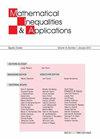近似ω-正交性和ω-导数
IF 0.7
4区 数学
Q2 MATHEMATICS
引用次数: 2
摘要
。我们引入了近似ω -正交的概念(指数值半径ω),并研究了它的显著性。设T, S∈B (H), ε∈[0,1]。我们说T近似于S正交,我们写成T⊥εω S if ω 2 (T + λ S) (cid:2) ω 2 (T)−2 εω (T) ω (λ S),对于所有λ∈C。我们证明了T⊥εω S当且仅当inf θ∈[0,2 π] D θω (T, S) (cid:2)−εω (T) ω (S),其中D θω (T, S) = lim r→0 + ω 2 (T + re i θ S)−ω 2 (T) 2r;当且仅当对于每一个θ∈[0,2 π], H中存在一个单位向量序列{x θ n},使得且其中ω (T)是T的数值半径。,本文章由计算机程序翻译,如有差异,请以英文原文为准。
Approximate ω-orthogonality and ω-derivation
. We introduce the notion of approximate ω -orthogonality (referring to the numerical radius ω ) and investigate its signi fi cant properties. Let T , S ∈ B ( H ) and ε ∈ [ 0 , 1 ) . We say that T is approximate ω -orthogonality to S and we write T ⊥ εω S if ω 2 ( T + λ S ) (cid:2) ω 2 ( T ) − 2 εω ( T ) ω ( λ S ) , for all λ ∈ C . We show that T ⊥ εω S if and only if inf θ ∈ [ 0 , 2 π ) D θω ( T , S ) (cid:2) − εω ( T ) ω ( S ) in which D θω ( T , S ) = lim r → 0 + ω 2 ( T + re i θ S ) − ω 2 ( T ) 2 r ; and this occurs if and only if for every θ ∈ [ 0 , 2 π ) , there exists a sequence { x θ n } of unit vectors in H such that and where ω ( T ) is the numerical radius of T . ,
求助全文
通过发布文献求助,成功后即可免费获取论文全文。
去求助
来源期刊
CiteScore
2.30
自引率
10.00%
发文量
59
审稿时长
6-12 weeks
期刊介绍:
''Mathematical Inequalities & Applications'' (''MIA'') brings together original research papers in all areas of mathematics, provided they are concerned with inequalities or their role. From time to time ''MIA'' will publish invited survey articles. Short notes with interesting results or open problems will also be accepted. ''MIA'' is published quarterly, in January, April, July, and October.

 求助内容:
求助内容: 应助结果提醒方式:
应助结果提醒方式:


